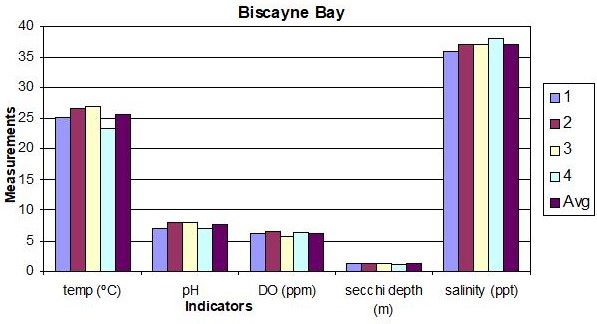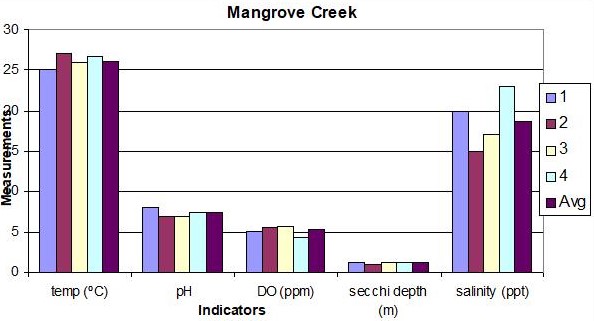Biscayne Bay: This is an open area of the coast line that is exposed to ocean currents and tides.
Mangrove Creek: This is a backwater area with occasional flooding of sea water.
Results: Readings at the two locations are shown in the graphs along with the average values.


- Secchi depth different at the two sites. The average of the readings suggest that the secchi depth is the same at both the sites. If the disk hit the bottom before it disappeared then it means that the results are not an accurate reflection of turbidity. Typically, at the bottom, the turbidity would be higher. If the water were deeper, then the Biscayne Bay area would have shown higher values since waters in the sea are free from sediments than when compared to the mangrove creek area.
- Temperature Difference. Temperature difference does exist in both the areas. The average temperature for Biscayne Bay was 25.5 degree centigrade while that for Mangrove Creek was 26.2 degree centigrade. The difference is because the bay area has tides and waves that tend to move warm water into colder areas and so the water does not remain steady to gain heat. In the mangrove backwater area, the heat from the land and the relatively still waters or water flowing into the bay means the water heats more hence the higher temperature.
- Salinity Difference. The water sample at Biscayne bay is more saline and has a ppt of 37 while that of Mangrove is 18.4. The difference is because the seawater in the bay has more dissolved salts while the mangrove area gets some fresh water from streams that may reduce the salinity.
- pH Difference. pH concentration at Biscayne bay area is more and at 7.5 when compared to the reading at Mangrove where the average was 7.4 pH. This is because the bay area has more dissolved salts while the mangrove area would react with soil minerals to reduce the acidity.
- DO Difference. The dissolved oxygen in Bay is higher at an average value of 6.15 while the mangrove has a value of 5.2. This is mainly because the sea water plants in the bay area would be much more and release oxygen. The water in the mangrove creek would have certain decaying leaves and plants that would consume oxygen.
- Turbidity affect on marine organisms. As the turbidity level rises, lesser sunlight enters the waters and this retards the growth of planktons, algae and other autotrophic life forms. These organisms live by photosynthesis and by extracting dissolved salts. When turbidity rises, the life forms have lesser nourishment and they are available in limited forms. The life forms are the bottom most in the food chain and are in turn consumed by the saprobes, saprophytes and other heterotrophic life. With higher turbidity, even fish and birds would find lesser oxygen and insects that feed on the basic life forms and life will be reduced.
- Temperature Measurement Immediately. Temperature was measured immediately after the aqua tube was extracted otherwise the water sample extracted would soon exchange heat with the ambient temperature and become warm or colder. The sample would have the same temperature as of the outside environment. By measuring the temperature immediately, we have ensured that temperature from the depth has been recorded.
- Temperature and Salinity. If the sample was allowed to rest in the sun, the temperature of the sample would have risen. As the temperature rise, the salinity would decrease since water would be able to absorb more salt at higher temperatures.